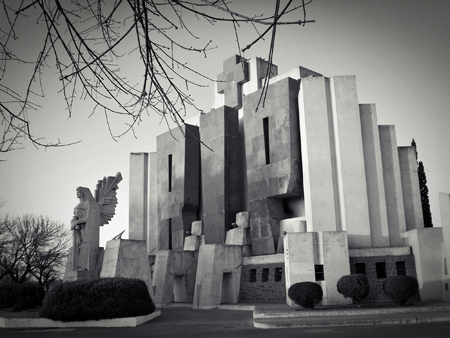
Much remains unknown about the life of Francisco Salamone, including his birthplace. Some authors say he was born in Italy while other claim Buenos Aires as his hometown. Uncertainty even carries over to Salamone’s large body of work, scattered throughout Argentina. Fans are discovering more & more of his buildings, but here’s what we know for sure…
After studying architecture & engineering at several different universities in Argentina, Salamone received his degree in 1917. Through his friendship with Manuel Fresco, governor of the Province of Buenos Aires, he got a big break. Hired to design & modernize public works throughout the province, Salamone constructed over 60 buildings in his trademark style between 1936 & 1940.
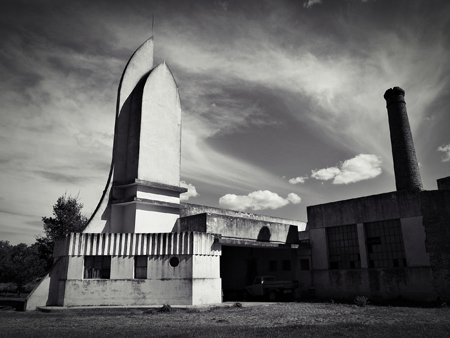
Breaking through the flat grasslands of La Pampa, Salamone designed towering white structures which could be seen easily from a distance. Governor Fresco liked Mussolini—a fairly common trait in Italian descendants in Argentina in those days—and gave Salamone free reign to build something that would fit in with modern, Fascist design. The end product was futuristic, something completely unexpected in small towns seemingly in the middle of nowhere.
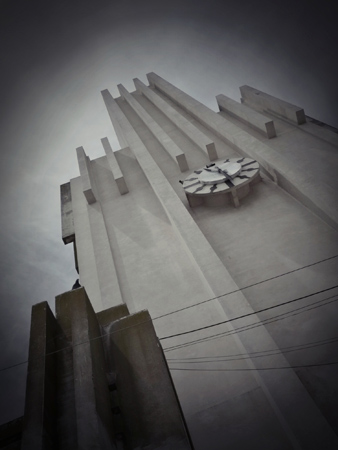
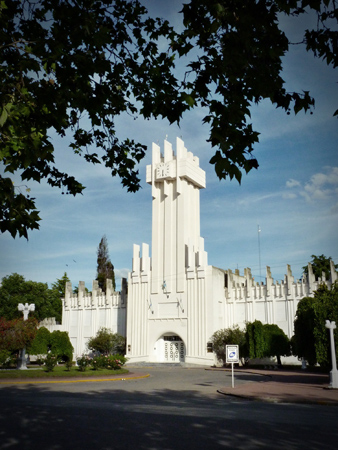
Salamone’s works can be divided into general categories: town halls, cemeteries & slaughterhouses. He designed other buildings as well, but those three comprised the bulk of his work. He even worked on smaller projects like benches & light fixtures for plazas.
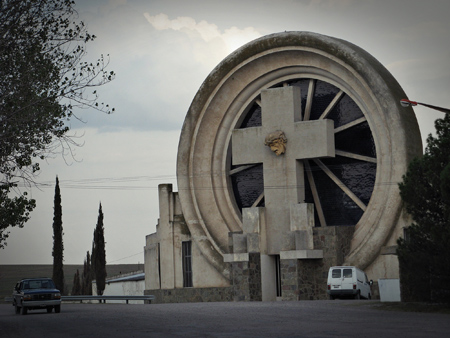
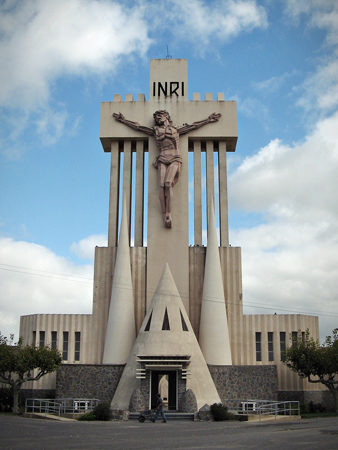
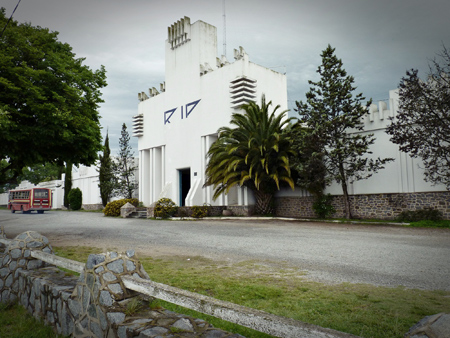
Many have now fallen into disuse, but the rise of tourism in Argentina over the last ten years as well as an increased focus on the nation’s architectural heritage has made Salamone popular once again. Restoration projects have begun & weekend excursions go to towns that are difficult to connect using public transportation alone.
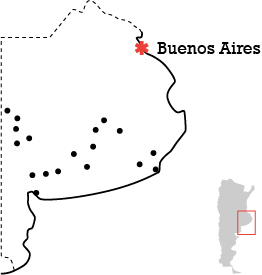
Salamone passed away in 1959 & was originally buried in Recoleta Cemetery. An obituary newspaper column announced the following:
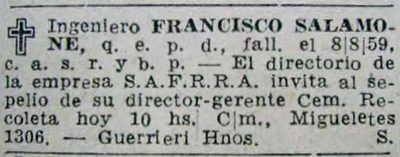
Unfortunately, architecture buffs can no longer pay their respects in Recoleta Cemetery. After spending five years in the Lippo mausoleum, Salamone’s casket was transferred in 1964 to the López Vida family vault. But that wasn’t the end of his journey. We also discovered that he was taken to Jardín de Paz in Pilar in 1992 thanks to Rick Caba. Motives for moving around are still unknown, but all three resting places are shown below:
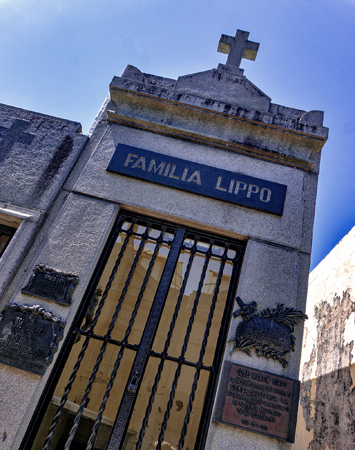
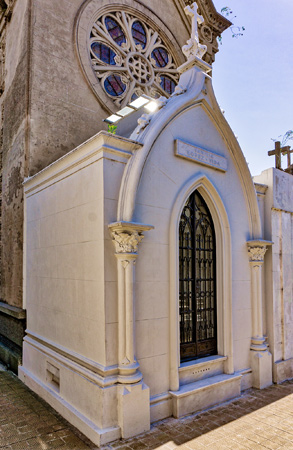
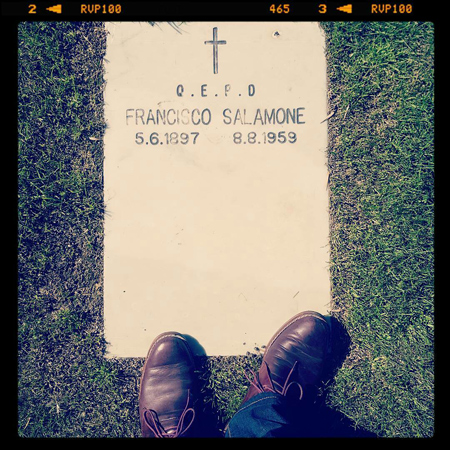
Salamone has been included in AfterLife due to his importance in national architecture + as one more example of a temporary Recoleta Cemetery burial.
There are a variety of online sources about the architecture of Salamone (in Spanish). With the exception of Rick Caba’s tombstone photo (used with permission), all pics are from Marcelo Metayer who administers the architect’s Flickr group. Andrés Tórtola filmed two travel documentaries about Salamone, & Edward Shaw talks about returning to the works of Salamone ten years after his first visit.
Great photos.
Thanks, Daniel. I’ll let Mar know. He’s a fantastic photographer & a bit obsessed with Salamone. It’s a good thing.
The pictures from Metayer are quite good. An excellent job was done for all the team, congratulations.
Thanks very much, Eduardo! Glad you enjoyed the post!
Hola Robert
Hay post sobre Natalio Botana fundador del diario Critica que esta en la Recoleta?,fue famoso el Mural que le encargo a siqueiros en el sotano de su casa(Te recomiendo la Pelicula El Mural de Olivera)
Estuvo casado con Salvadora medina Onrrubia militante anarquista .
En esa Boveda estuvo Alfonsina Storni antes de ser trasladada a la Chacarita
Saludos
Pablo
Hola Pablo – Acabo de escribir algo sobre el Museo del Bicentenario y Siqueiros (para un PDF sobre Plaza de Mayo), pero no sabia que Botana está enterrado en la Recoleta. Alucinante. La semana que viene tengo que ir a sacar fotos asi que pregunto en Administración. Sería un buen post. Gracias por el dato! Saludos!
Hola.
Te dejo Biografias sacadas de Boyana y Salbadora Medina Onrrubia
Natalio Félix Botana Miralles empresario periodístico uruguayo radicado en Buenos Aires, nació el 8 de septiembre de 1888 en Sarandí del Yí, Durazno y murió el 7 de agosto de 1941, en Jujuy, Argentina, luego de dos días de agonía producto de un accidente automovilístico.
En 1913, cuando llegó a Buenos Aires, comenzó a trabajar en diferentes redacciones hasta que llega a La Razón y muy pronto se ganó un lugar en la historia del periodismo argentino al fundar cuando tenía 25 años el Diario Crítica. Fue un personaje tanto amado como odiado pero todos están de acuerdo que revolucionó el periodismo en ambas márgenes del Río de la Plata.
El diario fue innovador al dejar la solemnidad y elegir un lenguaje popular mezclando sensacionalismo, denuncia y artículos de varios escritores como Raúl González Tuñón, Roberto Arlt, Jorge Luis Borges, Enrique González Tuñón, Carlos de la Púa, Bernardo Verbitsky, pasando por notas del físico Albert Einstein o el Premio Nobel George Bernard Shaw. Tenía un gran olfato para seleccionar temas de interés para el público masivo.
Su fastuosa quinta de Don Torcuato fue visitada por los personajes más famosos de la época, desde Pablo Neruda hasta José Ortega y Gasset, y tenía un mural pintado por el mexicano David Alfaro Siqueiros en el que aparecía desnuda Blanca Luz Brum, esposa de Siqueiros y, al parecer, amante de Botana.
Salvadora Medina Onrubia (1894 – 1972)
fue una narradora, poetisa, anarquista y feminista de origen judío, nacida en Argentina en 1894 en La Plata, Argentina y muere en 1972 en Buenos Aires.
En 1918, comienza su actividad literaria. Fue colaboradora de La Nación, El Hogar, Caras y Caretas y otras publicaciones. Autora de varias de piezas dramáticas y propulsora del teatro para niños. En 1915, se casó con Natalio Botana el creador del diario Crítica, que ella dirigió entre 1946 y 1951 después de la muerte de su esposo.
En Internet hay mucho mas sobre Natalio Botana y Salvadora Medina Onrrubia.
Saludos
Pablo
PD:En esa Boveda estuvo Alfonsina Storni antes de ser trasladada a la Chacarita
Las saque de Wikipedia
Es Salvadora Salvadora Medina Onrubia,No Onrrubia yo me confundi
Buenísimo! Está semana me fijo si encuentro el mausoleo. Saludos!
Specializing in slaughterhouses would seem grimly appropriate for a Fascist architect.
I never thought about it, but you’re absolutely right!